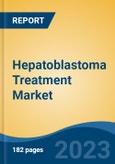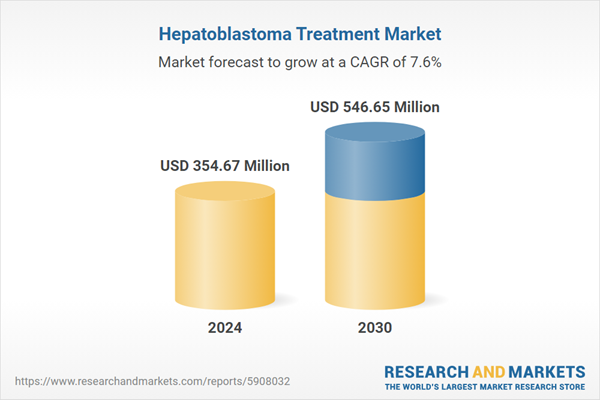Speak directly to the analyst to clarify any post sales queries you may have.
10% Free customizationThis report comes with 10% free customization, enabling you to add data that meets your specific business needs.
Key Market Drivers
Increasing Incidence of Hepatoblastoma
The increasing incidence of hepatoblastoma has emerged as a pivotal driver propelling the growth of the Global Hepatoblastoma Treatment Market. For instance, a 2024 article published in Frontiers explores cancer immunogenic cell death through pyroptosis using CXCR4-targeted nanotoxins in hepatocellular carcinoma. This study highlights how nanotoxins specifically targeting CXCR4 can induce pyroptosis, a form of programmed cell death, enhancing anti-tumor immunity.These findings offer promising advancements in immunotherapy strategies for hepatocellular carcinoma treatment. Hepatoblastoma, a rare pediatric liver cancer, has seen a notable uptick in diagnosed cases in recent years. This rise in prevalence, particularly among infants and young children, has spurred a growing demand for innovative and effective treatment solutions. While hepatoblastoma remains relatively uncommon, the steady increase in its incidence has intensified efforts within the medical community and the pharmaceutical industry to address the disease comprehensively.
The surge in hepatoblastoma cases underscores the urgency of developing advanced treatment modalities to combat this challenging cancer effectively. Early diagnosis and intervention are critical in hepatoblastoma cases, and the escalating number of patients diagnosed underscores the pressing need for treatment options that can provide favorable outcomes. This growing incidence has not only heightened awareness about the disease but has also encouraged healthcare providers and researchers to explore novel therapeutic approaches.
The increasing incidence of hepatoblastoma has galvanized funding and support from governments, research institutions, and nonprofit organizations. This financial backing has spurred research and development activities, leading to the discovery of more targeted and efficacious treatment strategies. As the medical community continues to unravel the complexities of hepatoblastoma and its underlying causes, innovative treatments are emerging, offering renewed hope to patients and their
Key Market Challenges
Limited Awareness and Early Diagnosis
Hepatoblastoma, a rare form of liver cancer that predominantly affects young children, presents a unique challenge to the global healthcare community. While advances in medical science have improved treatment options and survival rates, the battle against hepatoblastoma faces a significant obstacle: limited awareness and early diagnosis. Hepatoblastoma is often described as a silent threat due to its relatively low incidence rate and nonspecific symptoms in its early stages. Children affected by this cancer may experience abdominal pain, weight loss, or a lump in the abdomen, which can be easily overlooked or misattributed to less severe conditions. Consequently, diagnosis often occurs at later, more advanced stages of the disease, making treatment more challenging and less effective.The delayed diagnosis of hepatoblastoma has profound consequences. At advanced stages, the cancer may have already spread to other parts of the liver or distant organs, reducing the likelihood of a complete cure. Timely intervention is critical to improving survival rates and minimizing the intensity of treatment required. Unfortunately, limited awareness among parents, caregivers, and healthcare providers often leads to a protracted diagnostic journey.
Key Market Trends
Advances in Precision Medicine
Advances in precision medicine have emerged as a groundbreaking trend that is significantly boosting the global hepatoblastoma treatment market. Precision medicine, also known as personalized medicine, is a revolutionary approach that tailors treatment strategies to the specific genetic and molecular characteristics of individual patients. In the context of hepatoblastoma, this approach has ushered in a new era of hope and improved outcomes for young patients facing this rare liver cancer.One of the key breakthroughs in precision medicine for hepatoblastoma is the identification of specific genetic mutations and markers associated with the disease. Researchers have delved deep into the molecular biology of hepatoblastoma, uncovering critical insights into the mechanisms driving its growth and progression. This newfound knowledge has paved the way for the development of targeted therapies that precisely address these specific molecular aberrations. These targeted therapies are designed to disrupt the signaling pathways or cellular processes that promote hepatoblastoma growth while sparing healthy tissues from harm. Unlike traditional chemotherapy, which can cause systemic side effects, these precision medications are more selective, leading to improved treatment effectiveness and a reduction in adverse events.
Key Market Players
- Eureka Therapeutics.
- Fennec Pharmaceuticals Inc.
- Eli Lilly and Company
- Bristol-Myers Squibb Company
- Cipla Limited
- Pfizer Inc.
- AstraZeneca Plc
- Boston Scientific Corporation
- Nantong Haier's Pharmaceutical co. ltd
- GSK plc
Report Scope:
In this report, the Global Hepatoblastoma Treatment Market has been segmented into the following categories, in addition to the industry trends which have also been detailed below:Hepatoblastoma Treatment Market, By Drug Class:
- Alkylating Agent
- Antibiotics
- Vinca Alkaloids
- Antimetabolites
- Others
- Hepatoblastoma Treatment Market, By Treatment
- Surgery
- Chemotherapy
- Targeted Therapy
- Radiation Therapy
- Ablation Therapy
- Others
- Hepatoblastoma Treatment Market, By End User
- Hospitals & Clinics
- Ambulatory care Centers
- Others
Hepatoblastoma Treatment Market, By Region:
- North America
- United States
- Canada
- Mexico
- Europe
- France
- United Kingdom
- Italy
- Germany
- Spain
- Asia-Pacific
- China
- India
- Japan
- Australia
- South Korea
- South America
- Brazil
- Argentina
- Colombia
- Middle East & Africa
- South Africa
- Saudi Arabia
- UAE
- Egypt
Competitive Landscape
Company Profiles: Detailed analysis of the major companies present in the Global Hepatoblastoma Treatment Market.Available Customizations:
With the given market data, the publisher offers customizations according to a company's specific needs. The following customization options are available for the report.Company Information
- Detailed analysis and profiling of additional market players (up to five).
This product will be delivered within 1-3 business days.
Table of Contents
Companies Mentioned
- Eureka Therapeutics.
- Fennec Pharmaceuticals Inc.
- Eli Lilly and Company
- Bristol-Myers Squibb Company
- Cipla Limited
- Pfizer Inc.
- AstraZeneca Plc
- Boston Scientific Corporation
- Nantong Haier's Pharmaceutical co. ltd
- GSK plc
Table Information
| Report Attribute | Details |
|---|---|
| No. of Pages | 180 |
| Published | March 2025 |
| Forecast Period | 2024 - 2030 |
| Estimated Market Value ( USD | $ 354.67 Million |
| Forecasted Market Value ( USD | $ 546.65 Million |
| Compound Annual Growth Rate | 7.6% |
| Regions Covered | Global |
| No. of Companies Mentioned | 10 |









